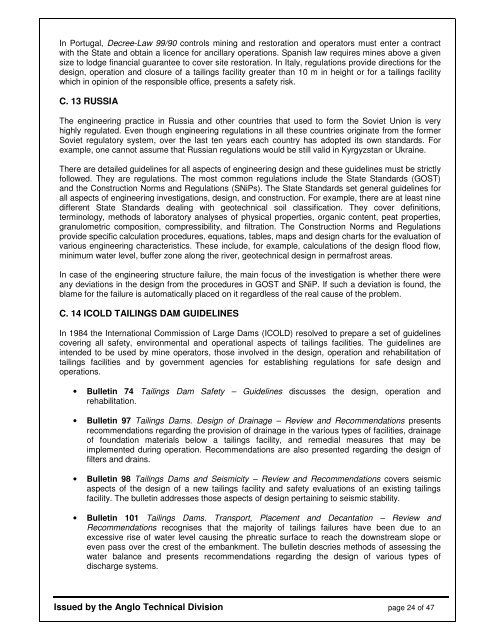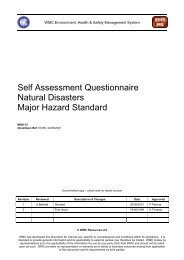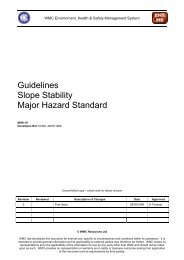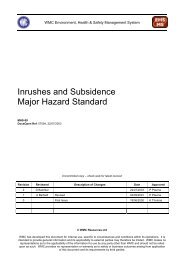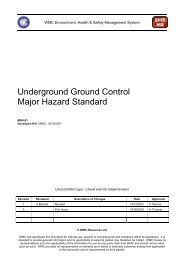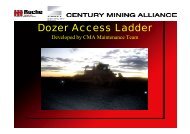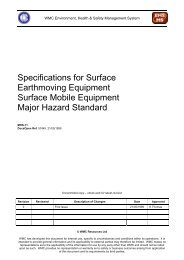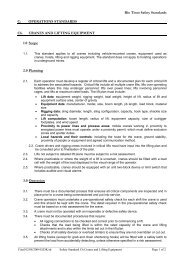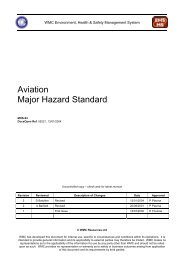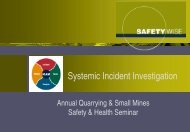SAFETY, HEALTH & ENVIRONMENT BULLETIN - MIRMgate
SAFETY, HEALTH & ENVIRONMENT BULLETIN - MIRMgate
SAFETY, HEALTH & ENVIRONMENT BULLETIN - MIRMgate
You also want an ePaper? Increase the reach of your titles
YUMPU automatically turns print PDFs into web optimized ePapers that Google loves.
In Portugal, Decree-Law 99/90 controls mining and restoration and operators must enter a contract<br />
with the State and obtain a licence for ancillary operations. Spanish law requires mines above a given<br />
size to lodge financial guarantee to cover site restoration. In Italy, regulations provide directions for the<br />
design, operation and closure of a tailings facility greater than 10 m in height or for a tailings facility<br />
which in opinion of the responsible office, presents a safety risk.<br />
C. 13 RUSSIA<br />
The engineering practice in Russia and other countries that used to form the Soviet Union is very<br />
highly regulated. Even though engineering regulations in all these countries originate from the former<br />
Soviet regulatory system, over the last ten years each country has adopted its own standards. For<br />
example, one cannot assume that Russian regulations would be still valid in Kyrgyzstan or Ukraine.<br />
There are detailed guidelines for all aspects of engineering design and these guidelines must be strictly<br />
followed. They are regulations. The most common regulations include the State Standards (GOST)<br />
and the Construction Norms and Regulations (SNiPs). The State Standards set general guidelines for<br />
all aspects of engineering investigations, design, and construction. For example, there are at least nine<br />
different State Standards dealing with geotechnical soil classification. They cover definitions,<br />
terminology, methods of laboratory analyses of physical properties, organic content, peat properties,<br />
granulometric composition, compressibility, and filtration. The Construction Norms and Regulations<br />
provide specific calculation procedures, equations, tables, maps and design charts for the evaluation of<br />
various engineering characteristics. These include, for example, calculations of the design flood flow,<br />
minimum water level, buffer zone along the river, geotechnical design in permafrost areas.<br />
In case of the engineering structure failure, the main focus of the investigation is whether there were<br />
any deviations in the design from the procedures in GOST and SNiP. If such a deviation is found, the<br />
blame for the failure is automatically placed on it regardless of the real cause of the problem.<br />
C. 14 ICOLD TAILINGS DAM GUIDELINES<br />
In 1984 the International Commission of Large Dams (ICOLD) resolved to prepare a set of guidelines<br />
covering all safety, environmental and operational aspects of tailings facilities. The guidelines are<br />
intended to be used by mine operators, those involved in the design, operation and rehabilitation of<br />
tailings facilities and by government agencies for establishing regulations for safe design and<br />
operations.<br />
• Bulletin 74 Tailings Dam Safety – Guidelines discusses the design, operation and<br />
rehabilitation.<br />
• Bulletin 97 Tailings Dams. Design of Drainage – Review and Recommendations presents<br />
recommendations regarding the provision of drainage in the various types of facilities, drainage<br />
of foundation materials below a tailings facility, and remedial measures that may be<br />
implemented during operation. Recommendations are also presented regarding the design of<br />
filters and drains.<br />
• Bulletin 98 Tailings Dams and Seismicity – Review and Recommendations covers seismic<br />
aspects of the design of a new tailings facility and safety evaluations of an existing tailings<br />
facility. The bulletin addresses those aspects of design pertaining to seismic stability.<br />
• Bulletin 101 Tailings Dams. Transport, Placement and Decantation – Review and<br />
Recommendations recognises that the majority of tailings failures have been due to an<br />
excessive rise of water level causing the phreatic surface to reach the downstream slope or<br />
even pass over the crest of the embankment. The bulletin descries methods of assessing the<br />
water balance and presents recommendations regarding the design of various types of<br />
discharge systems.<br />
Issued by the Anglo Technical Division page 24 of 47


